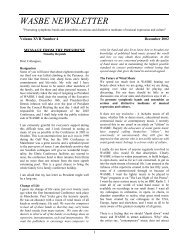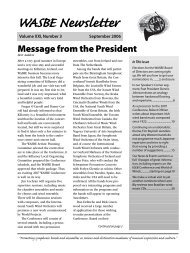March 2011 - World Association for Symphonic Bands and Ensembles
March 2011 - World Association for Symphonic Bands and Ensembles
March 2011 - World Association for Symphonic Bands and Ensembles
Create successful ePaper yourself
Turn your PDF publications into a flip-book with our unique Google optimized e-Paper software.
BOOK REVIEW<br />
The Best We Can Be – The Story of<br />
the Ithaca High School B<strong>and</strong>, 1955-<br />
67 by Frank L. Battisti <strong>and</strong> R. Bruce<br />
Musgrave; Galesville, MD, USA:<br />
Meredith Music Publications, 2010;<br />
Language: English; ISBN: 978-1-<br />
57463-159-3; US$34.95; 208 Pages.<br />
The publisher tells us that he originally had<br />
no intention of publishing this book but that<br />
he agreed as a friend to review it <strong>and</strong><br />
provide the author, Frank Battisti, with some<br />
comments. However, once he started<br />
reading it, he “…simply couldn’t put it<br />
down.” This reviewer’s reaction was much<br />
the same. When the publisher sent me the<br />
book to review, I wondered why I would<br />
want to read a chronology of an American<br />
high school b<strong>and</strong>, but after only a few<br />
pages, I realized how much this book has to<br />
say about developing a quality Wind B<strong>and</strong><br />
program <strong>and</strong> music education in general.<br />
The Ithaca High School B<strong>and</strong> program<br />
under Frank Battisti has long been known in<br />
the b<strong>and</strong> world <strong>for</strong> having commissioned<br />
compositions <strong>for</strong> the Wind B<strong>and</strong>/Ensemble<br />
from leading composers of that time. In fact,<br />
between 1959 <strong>and</strong> 1967, the Ithaca High<br />
School B<strong>and</strong> commissioned <strong>and</strong> premiered<br />
17 compositions from such composers as<br />
Vincent Persichetti, Arm<strong>and</strong> Russell, Leslie<br />
Bassett, Alec Wilder, Walter Hartley, <strong>and</strong><br />
Warren Benson. Compositions were also<br />
commissioned from Carlos Chavez, Karel<br />
Husa, Gunther Schuller, Alvin Etler, <strong>and</strong> Ernst<br />
Krenek but were withdrawn when Battisti<br />
left Ithaca High School in 1967. As<br />
impressive as the b<strong>and</strong>’s commissioning<br />
series is, the story of Battisti’s Ithaca High<br />
School B<strong>and</strong> is much more than even this<br />
tremendous accomplishment.<br />
Most interestingly, Battisti had one of the<br />
finest high school b<strong>and</strong> programs in the USA<br />
during his time as conductor of the Ithaca<br />
High School B<strong>and</strong>, but the <strong>March</strong>ing B<strong>and</strong>,<br />
Concert B<strong>and</strong> <strong>and</strong> the individual students<br />
never participated in any competition!<br />
Nonparticipation in contests was the policy<br />
at the High School when Battisti became<br />
b<strong>and</strong> director, <strong>and</strong> it remained so throughout<br />
his time there. Battisti’s skill as an educator<br />
was in getting young people to strive <strong>for</strong><br />
excellence by challenging themselves <strong>and</strong> in<br />
working together to create an environment<br />
of excellence.<br />
When Battisti became director <strong>for</strong> the<br />
Ithaca High School B<strong>and</strong>, he wished to<br />
eliminate or at least to place little emphasis<br />
on the <strong>March</strong>ing B<strong>and</strong>. However, the b<strong>and</strong>’s<br />
<strong>for</strong>mer director, who had become the school<br />
principal, encouraged Battisti to keep the<br />
<strong>March</strong>ing B<strong>and</strong> because of its significance in<br />
the school <strong>and</strong> community. Battisti then<br />
decided that if he was going to have a<br />
<strong>March</strong>ing B<strong>and</strong>, it should be one of excellence<br />
that would create a sense of teamwork<br />
<strong>and</strong> discipline in the participants. Thus the<br />
“Little Red <strong>March</strong>ing B<strong>and</strong>” of 79 students<br />
when Battisti took change became a 158<br />
piece <strong>March</strong>ing B<strong>and</strong> in 1967 with a<br />
national reputation, having per<strong>for</strong>med<br />
outst<strong>and</strong>ing halftime shows <strong>for</strong> nationally<br />
televised professional football games.<br />
The Concert B<strong>and</strong> quickly became known<br />
<strong>for</strong> its excellent per<strong>for</strong>mances <strong>and</strong> the quality<br />
of the music it per<strong>for</strong>med. Frederick Fennell<br />
was so impressed with the b<strong>and</strong> program<br />
that he spent one day each year from 1960<br />
to 1967 at Ithaca High School rehearsing the<br />
b<strong>and</strong>. By 1965, the b<strong>and</strong>’s reputation was so<br />
strong that it received an invitation to<br />
per<strong>for</strong>m at the Midwest Clinic in Chicago,<br />
<strong>and</strong> the following school year an invitation<br />
to per<strong>for</strong>m at the MENC Conference in<br />
Boston. For both per<strong>for</strong>mances the b<strong>and</strong><br />
commissioned works – Alec Wilder’s Entertainment<br />
III <strong>for</strong> the Midwest Clinic <strong>and</strong> John<br />
Huggler’s Celebration, Opus 68 <strong>for</strong> the<br />
MENC Conference. These per<strong>for</strong>mances<br />
brought the b<strong>and</strong> to national prominence<br />
not only because of the outst<strong>and</strong>ing per<strong>for</strong>mances<br />
but because of the excellence of the<br />
music per<strong>for</strong>med.<br />
Battisti was a dem<strong>and</strong>ing teacher/conductor<br />
who expected <strong>and</strong> insisted that his<br />
players always do their very best. However,<br />
his dem<strong>and</strong>s on himself were higher than the<br />
expectations from his pupils. In addition to<br />
conducting full b<strong>and</strong> rehearsals, he gave<br />
each player a 30 minute lesson each week,<br />
coached small chamber music groups,<br />
conducted a brass choir, clarinet choir, flute<br />
choir, <strong>and</strong> percussion ensemble, gave<br />
evening <strong>and</strong> Saturday morning theory, music<br />
history, <strong>and</strong> conducting classes, commissioned<br />
composers, designed all of the<br />
halftime shows <strong>for</strong> football games <strong>and</strong><br />
arranged the music <strong>for</strong> them, organized<br />
b<strong>and</strong> trips <strong>and</strong> fund raising activities, <strong>and</strong> as<br />
Musgrave writes, “found ways of making<br />
every minute of the day productive.<br />
…Surrounded by adolescents brim-full of<br />
vitality of the most natural sort, he was the<br />
most vital one of all, right in their midst. He<br />
was getting every drop of life out of living –<br />
right down to limiting himself to five hours<br />
of sleep a night….”<br />
Part of what makes this book attractive<br />
reading is its <strong>for</strong>mat. Battisti tells the story of<br />
the b<strong>and</strong> during his years as conductor,<br />
providing the factual in<strong>for</strong>mation about<br />
commissions, guest soloists <strong>and</strong> conductors,<br />
b<strong>and</strong> camps, etc., while Musgrave, an<br />
English <strong>and</strong> mathematics teacher <strong>and</strong> school<br />
administrator, provides his reflections on the<br />
time he spent as a member of the Ithaca<br />
High School B<strong>and</strong> in the early 1960s. As with<br />
the chorus in an ancient Greek play, his<br />
essays with titles like “Leadership, Role<br />
Models <strong>and</strong> Mentors”; “Creativity”; “B<strong>and</strong><br />
Director or Coach”, “Competition <strong>and</strong><br />
Cooperation”; <strong>and</strong> “Dem<strong>and</strong>ing in Public,<br />
Supportive in Private” provide the<br />
commentary needed to underst<strong>and</strong> why this<br />
high school b<strong>and</strong> program was one of the<br />
finest in the years between 1955 <strong>and</strong> 1967.<br />
This book should be m<strong>and</strong>atory reading<br />
<strong>for</strong> any young person considering becoming<br />
a school b<strong>and</strong> director. For music students, it<br />
provides a wonderful “blueprint” <strong>for</strong> a qualitative<br />
program. For those still considering<br />
studying music, it is not only inspirational<br />
but also a warning that being a success in<br />
this field is as dem<strong>and</strong>ing as in any other<br />
branch of the music profession. For those in<br />
the profession, this book provides an<br />
impetus to strive <strong>for</strong> even higher achievements.<br />
Leon J. Bly<br />
WASBE <strong>World</strong> 27


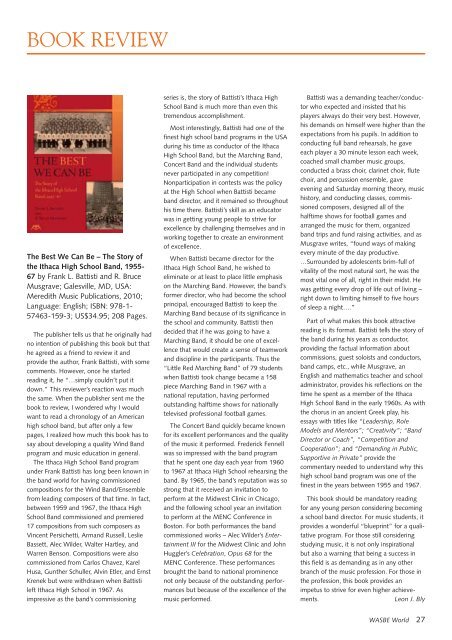
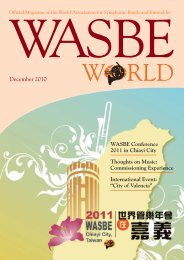
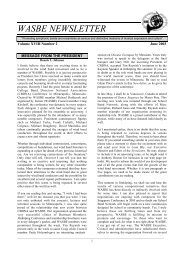

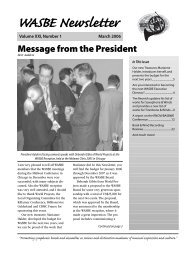
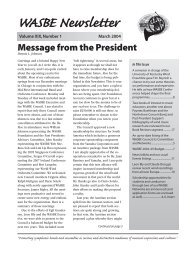

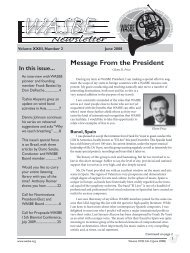
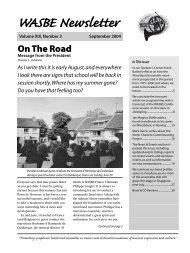
![application form [PDF; 110K]](https://img.yumpu.com/37266203/1/190x253/application-form-pdf-110k.jpg?quality=85)
